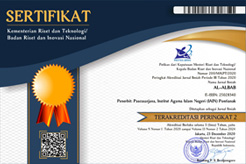Intrigues behind the Harem Wall: Social, Cultural and Political Construction of Life behind the Harem of Sultan Sulaiman I
Abstract
Keywords
Full Text:
PDFReferences
Ana Bilqis Fajarwati. 2013. “Islam dan Demokrasi Membaca Pemikiran Fatima Mernissi” in Jurnal Religio Jurusan Perbandingan Agama of Faculty of Ushuluddin IAIN Sunan Ampel Surabaya. Volume 03. Nomor 01. Tahun 2013 page: 60-78.
Christine Isom-Verhaaren. 2006. “Royal French Women in the Ottoman Sultans’ Harem: The Political Uses of Fabricated Accounts from the Sixteenth to the Twenty-first Century” in Journal of World History of the University of Hawai’i Press. Vol. 17, No. 2 Tahun 2006. Page: 72-83.
Colin Imber. 2012. Kerajaan Ottoman, Struktur Kekuasaan Sebuah Kerajaan Islam Terkuat dalam Sejarah. Jakarta: PT. Elex Media Komputindo Kompas Gramedia.
Diane M. Huddleston. 2012. “The Harem: Looking Behind the Veil.” Department of History Seminar Paper. Oregon: Western Oregon University.
Elizabeth Abbott. 2013. Wanita Simpanan: Kontroversi Selingkuhan Tokoh-Tokoh Dunia, dari Orang Suci Hingga Politisi, dari Zaman Kuno hingga Era Kini. Jakarta: Alvabet (translation).
Fatima Mernissi. 1999. Teras Terlarang (Kisah Masa Kecil Seorang Feminis Muslim). Bandung: Mizan (translation).Karen Armstrong. 2002. Islam: A Short History (Terjemahan: Sepintas Sejarah Islam). Yogyakarta: Ikon Teralitera (translation). Philip K. Hitti. 2002. History of The Arabs (Edisi Revisi 10). Jakarta: PT Serambi Ilmu Semesta.Simon Sebag Montefiore. 2012. Jerusalem The Biography. Jakarta: Alvabet (translation).
Internet:
Galina I. Yermolenko. 2009. Reading the Other: Roxolana In European History and Literature. Retrieved from http://www.nssa.us/journals/2009-32-1/2009-32-1-22.htm diakses 29 October 2015.
Miftahus Shurur. Hareem. Retrieved from: http://ppiturki.tripod.com/edisiiii/id7.html. 23 May 2013.
Gianna Carotenuto. Domisticating The Harem. Retrieved from: (http://www.international.Ucla.edu/asia/news/article.asp?parentid=93148) on 23 May 2013.
Tati Rohayati dkk. Dua Sisi Harem: Penghibur dan Pengatur Sultan. Retrieved from: (http://cacingpadangpasir.blogspot.com/2013/06/dua-sisi-harem-penghibur-dan-pengatur.html) on 3 July 2013
Article Metrics
 Abstract views: 3024
Abstract views: 3024
 PDF views: 1901
PDF views: 1901











